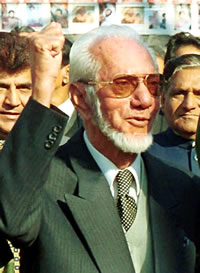Peace Watch » Editor's Take, Featured » Kashmir: 1947 Lies Exposed
Kashmir: 1947 Lies Exposed
Kashmir: 1947 Lies Exposed
BY
Z. G. Muhammad
Manufactured narratives’ do not stand the test of the time. Like a soap bubble this burst once put to the litmus test of history. Christopher Snedden, an Australian politico-strategic analyst, author and academic in South Asian studies in his recently released book, “Kashmir: the Unwritten History’ has dismantled much orchestrated ‘dominant discourse’ about the Kashmir ‘dispute.’
For over past sixty six five years New Delhi has been asserting that Kashmir’s ‘conditional accession’ with India and landing of Indian troops at Srinagar airport on 27 October 1947 was caused because of hordes of armed tribesmen with logistic support from Government of Pakistan descending on Kashmir and trampling down the troops of the feudal ruler. Moreover, it does not refer to the revolt in Poonch and Mirpur that had unnerved the Maharaja. Disputing India’s claim that India intervened in Kashmir because of ‘the invasion of Pukhtoon tribesmen from Pakistan. Christopher ‘locates the action of protests in Poonch and Mirpur by people long disenchanted with the Maharaja Hari Singh’s rule.’ Christopher Snedden in an interview with a New Delhi magazine said Sheikh Abdullah, Sardar Patel, and Nehru were in the know of the people’s revolt against Maharaja in these areas. “The secret correspondence between Jawaharlal Nehru and Sardar Patel make it clear that they were aware of what was going on. The evidence was always there but I do not know why these were not collected. India blamed Pukhtoon tribesmen for starting the conflict”. Sardar Ibrahim
The author has challenged the Indian claim that the violence started on 22 October 1947 after tribesmen ‘raided’ Kashmir. Many other important historians hold similar views. “The fact that senior politicians in New Delhi had decided weeks before 15 October that such an accession”, writes Alastair Lamb in his book Incomplete Partition, “was essential to Indian interest is not open to serious doubt. A letter from Nehru to Patel dated 27 September is sufficiently clear evidence for this conclusion.”… Nehru wanted to see the work done before the onset of winter. He had also written to Patel, “India must, therefore, act quickly, in cooperation with Sheikh Abdullah and his National Conference to bring about the preemptive accession of the state of Jammu and Kashmir to the Indian Union.” (Page 132). Historians from Alastair Lamb to Victoria Schofield gives details about India making preparation for ‘securing’ Kashmir months before 24 October 1947 and Sheikh Abdullah being in the loop – right from the day Sardar Patel secured his release from the Maharajas Jail. Many important historians agree that Sheikh Abdullah was released only to see Nehru-Patel plan bringing Jammu and Kashmir within Indian dominion executed without any hassles. Other important leaders like Chaudary Abbas continued to languish in jails.Sardar Qaayoom
The simmering discontent against the Maharaja Hari Singh in Poonch existed from 1940 when he had brought it in line with the administration of the state of Jammu and Kashmir and taxed every ‘hearth and window.’ “The loss of autonomy”, writes prominent Indian historian Ramachandra Guha, “as did new taxes imposed by the king…hardest hit were pastoralists of Poonch almost all of whom were Muslims.” ‘Within Poonch Muslims officials and soldiers had left their jobs in the state administration and joined the rebellion.’ Of the 71,667 soldiers from the state in the British army during second world war 60, 402 were Muslims from Mirpur and Poonch.’ On July 47, Hari Singh asked Muslims to surrender arms and distributed the same amongst Hindus and Sikh causing communal tension in Poonch and adjacent areas. Victoria Schofield writes, “They, therefore, sought fresh weapons from the tribes of North-West Frontier Province who were well known for their manufacture of weapons. This laid the basis for direct contact between the members of the Poonch resistance and the tribesmen who lived in the strip of mountainous tribal territory bordering Pakistan and Afghanistan.” (Kashmir in conflict page42). The ‘systematic purge of Muslims from Jammu’ and reports about Maharaja government using Dogra troops for terrorizing Muslims living in villages caused further anger in Poonch and Mirpur. The news also spread to tribal areas. Seen in historical perspective, it was not for the first time that tribesmen joined the Muslim rebellion in the state. In a span of seven years during the Sikh Rule (1819-1846), we find the tribesmen Afridis, Waziris, Gilzais, and Masudi’s twice joining the Muslim rebellion in the state for ending the occupation of Kashmir by the Sikhs. Therefore, there was nothing new in tribesmen joining rebellion led by thirty-two-year-old ‘Suddhan’ Sardar Muhammad Ibrahim Khan and Sardar Abdul Qayoom Khan. The story of rebellion, the defeat of the Dogra army and falling one after another town from Dheerkot Bagh to Gilgat is an important chapter in the military history of Kashmir. Snedden also subscribes to the view that Pakistan government was not directly involved as “ units of its army stranded deep in India.”
The author of the new book says that Nehru did not want to publicize the Poonch rebellion because it would have strengthened Pakistan’s case. India used tribesmen joining the 50000 strong rebel army led by Sardar Ibrahim Khan as an important basis for complaining against Pakistan to the United Nations and taking Kashmir to the United Nations. The UNSC after examining India’s complaint in its entirety did not declare Pakistan as an “aggressor” instead adopted resolutions for allowing people of the state right to decide the destiny through a Plebiscite. At these developments “Nehru was shocked”, writes Guha, “He bitterly regretted going to UN.” Most of Nehru biographer including M.J. Akbar endorses this view.
Indian narrative about tribesmen assisted Pakistan regulars after UN resolution, in essence, lost its sting. India later on hardly used it as a diplomatic baton to beat Pakistan in international forums instead looked for the legitimacy of accession in the instrument of accession. Nevertheless, surprisingly Sheikh Abdullah minus recess from 1953-1973 used the ‘manufactured narrative’ to subvert the popular discourse and strengthen the dominant discourse.
Making optimal use of his rhetoric from 1947 to 1953, he tried to hijack the public opinion not by distorting the facts only but also by engaging to quote Dr. Abdul Ahad through some “jobbing historians and writers” for conjuring narratives in tune with the dominant discourse thus causing gaps in our history. There is a need for filling up gaps in our history.
Filed under: Editor's Take, Featured · Tags: Christopher Snedden, Kashmir, Sardar Ibrhan Khan, Sardar Qayoom Khan, Sheikh Abdullah, Zahid G Muhmmad








India's lies exposed.